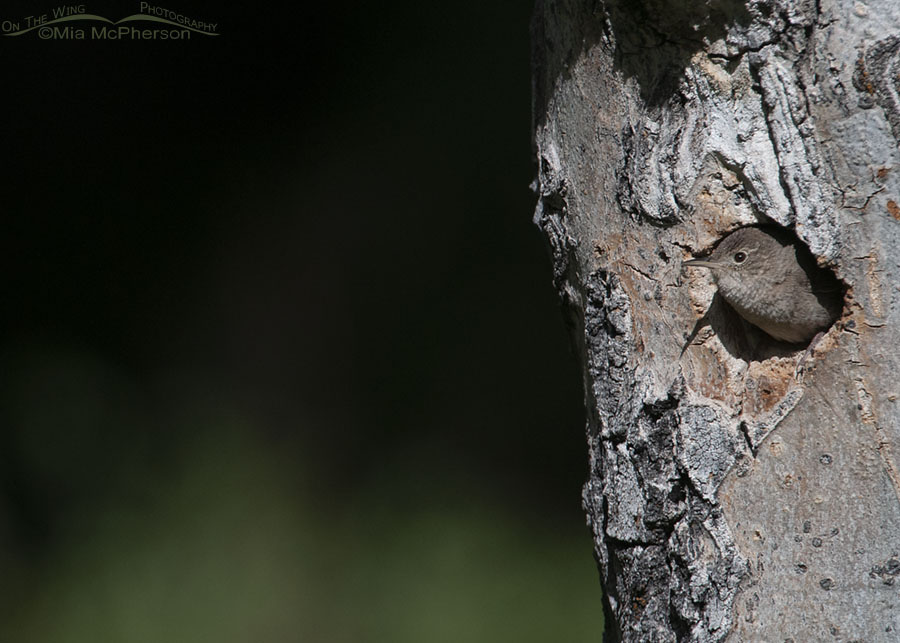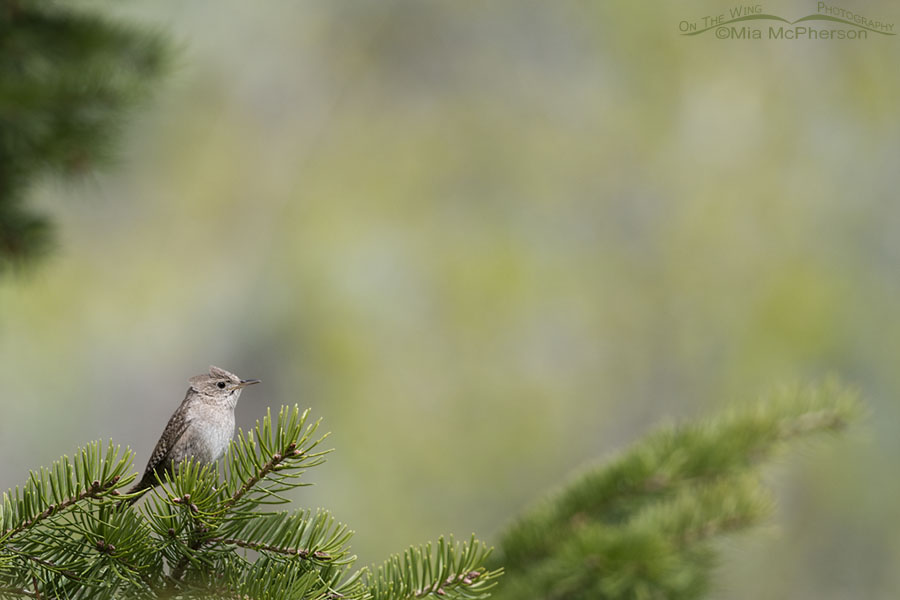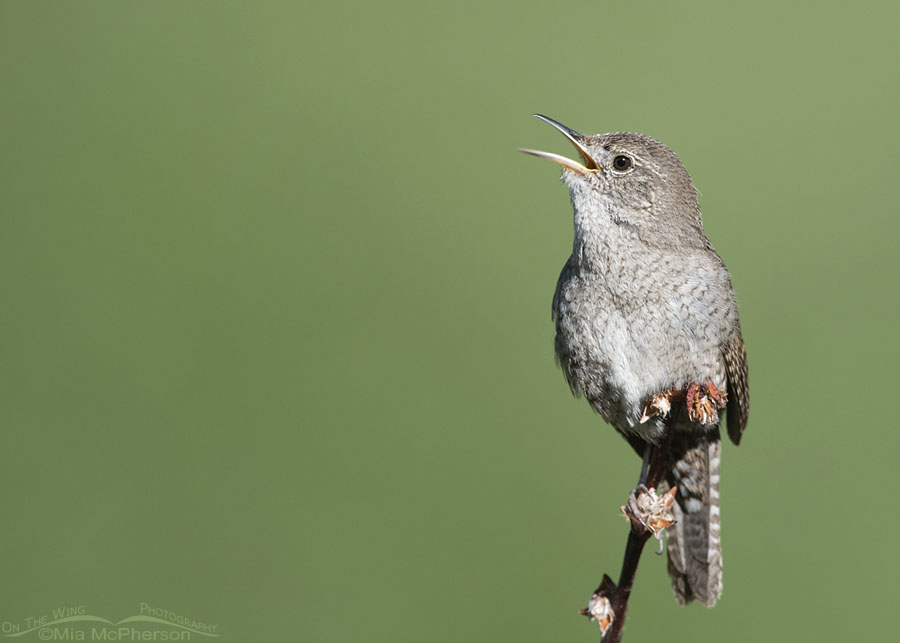Through the years I have discovered that my best opportunities for photographing some species of birds comes during their nesting season because they are busy building nests, incubating, and feeding their young near where they nest. I’ve found that to be the case with House Wrens. I know that if I can locate a nesting cavity, natural or man made, where they are nesting I can sit in a mobile blind at a respectful distance and photograph them coming to or flying away from their nest.
 House Wren peeking out of its nest – Nikon D300, f8, 1/1600, ISO 500, Nikkor 200-400mm VR with 1.4x TC at 400mm, natural light
House Wren peeking out of its nest – Nikon D300, f8, 1/1600, ISO 500, Nikkor 200-400mm VR with 1.4x TC at 400mm, natural light
When I am near nests or nesting birds I always follow these guidelines:
Ethics on photographing nesting birds:
- Do not approach too closely;
- If the birds show any sign of distress, back away;
- Don’t trim leaves, twigs or branches to get a clearer shot, you may inadvertently attract predators or cause the eggs/chicks to over heat;
- Follow local, state and federal guidelines concerning nesting birds;
- Don’t harass the birds to get an action shot;
- Don’t stay a long time with nesting birds or chicks, that disrupts their normal behavior;
- Always remember that your scent may draw predators to the area of nesting birds or birds with chicks.
For more information on the ethics of photographing nesting birds or chicks check out the Principles of Birding Ethics published by the American Birding Association.
My first best opportunities for photographing nesting House Wrens happened in 2014 because I was paying attention to the sounds I could hear on a forested mountain top on the Targhee National Forest of southeastern Idaho. When I followed the sound of a House Wren singing with my eyes I could see activity near a natural cavity in an aspen and saw a wren fly into it.
That particular aspen had several nesting cavities and because I discovered the wrens nesting there I was also able to spend time photographing Northern Flickers, Mountain Bluebirds, Tree Swallows, Williamson’s and Red-naped Sapsuckers, Mountain Chickadees, and Red-breasted Nuthatches all at that tree. This House Wren photo was taken at that location in May of 2014.
If I hadn’t been paying attention and focusing on the sights and sounds near me I would have missed out on many opportunities to photograph all the birds that nested in that tree or were attracted to it because of all of the sounds and activity of the birds that were nesting there. That isn’t just luck, it is a skill that I have worked hard to develop over the years.
 House Wren at the edge of a forest – Nikon D810, f7.1, 1/500, ISO 400, Nikkor 500mm VR with 1.4x TC, natural light
House Wren at the edge of a forest – Nikon D810, f7.1, 1/500, ISO 400, Nikkor 500mm VR with 1.4x TC, natural light
Once in a while I’ll see or hear House Wrens away from any nests that I am aware of during the breeding season and when that occurs I start to look around for nesting cavities. When I saw this House Wren perched on the branch of a conifer in June of 2016 in Clark County, Idaho I also found a snag that had several old nesting cavities in it. I didn’t have the best of luck photographing nesting House Wrens at that location but I stored the information away in my brain and I’ll check that snag out should I return to that area.
 Singing House Wren in the Wasatch Mountains – Nikon D500, f7.1, 1/1000, ISO 500, Nikkor 500mm VR with 1.4x TC, natural light
Singing House Wren in the Wasatch Mountains – Nikon D500, f7.1, 1/1000, ISO 500, Nikkor 500mm VR with 1.4x TC, natural light
Finding and photographing House Wrens in Utah means trips up into the Wasatch and Uinta Mountains for me because over the years I’ve learned that I can find them in many locations in our mountain ranges reliably during the breeding season. I listen for them often.
This House Wren was photographed last June where it and its mate were nesting in a man made nest box very close to where it sang from the top of this branch. I wasn’t aware that the wrens were nesting there until the day I took this photo so you might wonder why I was stopped at that location. It was due to my observation skills. Earlier in the season I had noticed that this branch was also a favorite perch for a male Broad-tailed Hummingbird last year and apparently this year as well. When this wren popped up on the branch it to sing was a wonderful surprise.
To photograph House Wrens and other birds I know I need to find them which means focusing my attention on the sights and sounds around me. Whenever I am out in the field I pay attention to everything and that has worked extremely well for me.
Life is good. Stay safe.
Mia
Click here to see more of my House Wren photos plus facts and information about this species.


Nicely observed and I can almost hear its song in the third photo.
It never ceases to amaze me how you can take a bird as common as a House Wren and turn it into something magical. Great narrative to compliment your beautiful shots. Thanks Mia.
Your stunning photos first drew me in – and your ethics keep me coming back.
Thank you.
The first Aspen in the Targhee NF is truly “The Giving Tree.” What a joy it must have been to see all the different species in one tree like that.
I haven’t seen any House Wrens yet, but “my” House Finch has been back on and off this week to test his reflection in my clerestory windows.
Very nice group of photos. Last year I watched as house wrens delivered many spiders to their young in the campsite kiosk roof. They were so use to humans they would land on the table a few feet away from us sitting at the table.
I just love House Wrens. I saw my FOY House Wrens this past week.